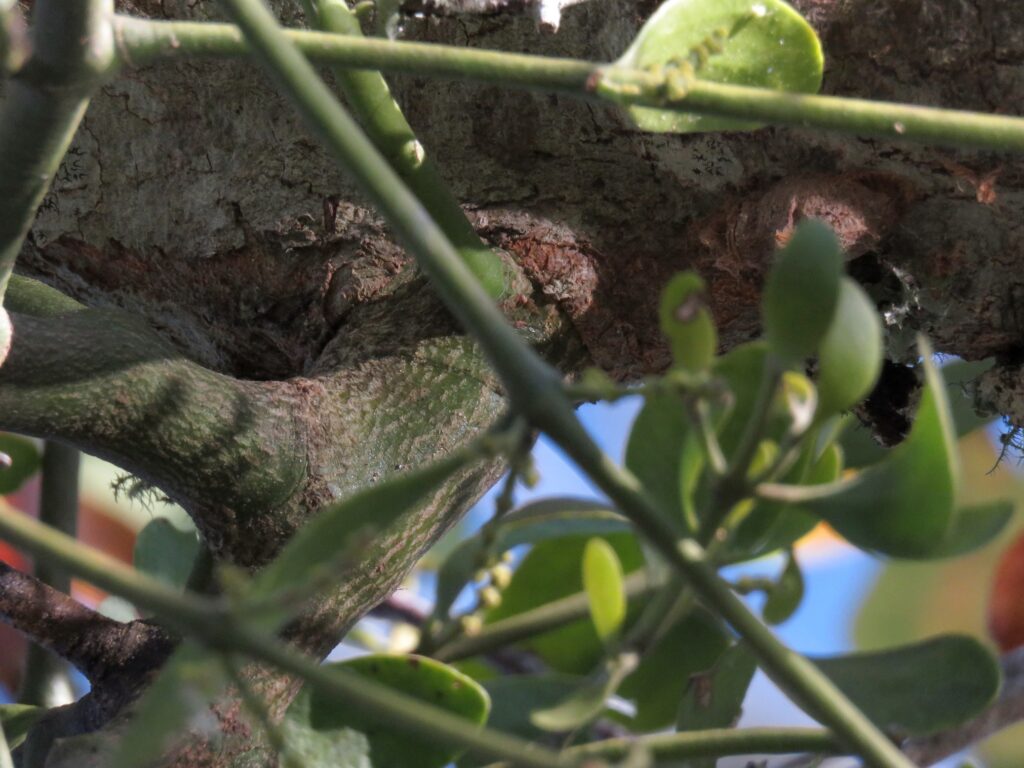





This week for Flora and Fauna Friday, were looking at our third and final festive plant. This partial parasite is a common site dangling from deciduous trees and doorways alike: Oak Mistletoe, Phoradendron leucarpum.
Oak Mistletoe is one of many species of Mistletoe found throughout the US but the only species found here in the Southeastern US. It is a small shrub with thick, leathery, evergreen leaves and pearl-white berries. However, unlike most shrubs it grows not on the ground but high in the air. Oak Mistletoe is parasitic in nature. It grows on and inside the branches of deciduous hardwood trees. I’ll go in depth on this later.
Oak Mistletoe is one of those species whose names say quite a lot about it. First, let’s dig into its scientific name, Phoradendron leucarpum. The specific epithet, leucarpum, translates directly as “White-Fruit” and this species indeed has prominent white fruits. The genus name, Phoradendron, can be interpreted one of two ways. The direct translation is along the lines of “Beared/Carried by Trees” but it can also be interpreted as “Thief of Trees”. Both of these translations are correct in regards to the biology of Mistletoes. Mistletoes are both supported physically and nutritionally by their host trees and they also steal nutrients and water from their host. So an appropriate translation of the scientific name could be “The white-fruited plant that steals from and is supported by trees.” The common name, Oak Mistletoe, sheds some light on the plant’s life history. It makes it rather obvious that Oaks are a common host for the species. Additionally, the term “Mistletoe” is derived from middle English word “Misteltan”, which is a compound word for “excrement” and “twig”. The plant is, in fact, dispersed by bird droppings that land on twigs.
Oak Mistletoe starts life as a seed, on a twig, in a pile of bird droppings. From there it germinates and quickly adheres itself to the bark of the host. Then the plant produces roots that penetrate the bark of its host and enter its vascular tissue. From here on out, Mistletoe grows like any other evergreen shrub. However, instead of spreading its roots through the soil in search of water and nutrients, it roots into the flesh of a tree and absorbs water and nutrients straight from its host. Oak Mistletoe is only a hemi-parasite. It photosynthesizes nearly all of its own food but it relies on a host for water and nutrients. As the branch of the host plant grows, so does the Mistletoe. It can reach about the size of a yoga ball. In our area, I most commonly find Oak Mistletoe growing on the branches of Water Oaks and Laurel Oaks but it can be found on many species of deciduous hardwood including Maples and most Oaks. Mistletoe photosynthesizes throughout the winter, so it prefers deciduous trees. Evergreen trees, like Live Oak, typically don’t allow enough light through their canopy for Mistletoe to survive. The fruit of Mistletoe matures in winter and is an important food source for many bird species, especially Bluebirds, Cedar Waxwings, and Northern Mockingbirds. Oak Mistletoe is also the host plant for the Great Purple Hairstreak, the largest species of Hairstreak butterfly in North America. Oak Mistletoe can be harmful to trees as it causes extra water stress in summer and the added weight can break branches. However, it is typically not an issue for healthy trees or if it is only present in small quantities.
The tradition of kissing under the Mistletoe dates back to Norse mythology and the legend of Baldur. I won’t re-tell the tale but it ends with Mistletoe becoming a conduit for a goddess’s “kiss” or blessing to all who pass beneath the plant. From this legend our modern tradition eventually evolved. Oak Misteltoe provides a blessing to wildlife who visit it too. It is an important food source for wildlife and acts as a conduit that harvests resources from its host tree and distributes it to wildlife during the hardest months of the year. Throughout the year it supports one of our most striking species of butterfly.
Oak Mistletoe may be a parasitic mooch and a re-gifter at that but even it is well versed in the spirit of giving. Have a Merry Christmas and Happy Holidays!